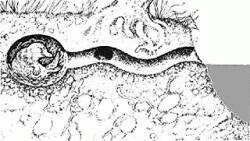 
The platypus is a semiaquatic, egg-laying mammal native to Tasmania and southern and eastern Australia. The animal has a bill that resembles a duck's bill but is actually an elongated snout covered with soft, moist, leathery skin and sensitive nerve endings. The bill is used for detecting prey and stirring up mud at the bottom of rivers to uncover the insects, worms, and shellfish on which the platypus feeds. The tail is flattened like a beaver's, and the feet are webbed. The head is joined directly to the body without an apparent neck.  It lays eggs like a bird or a reptile (this makes it a monotreme mammal). The mother platypus lays two eggs and keeps them warm by placing them on her belly and covering them with her
tail. In about two weeks they hatch. The baby platypi are naked and helpless. The mother's milk comes out through glands on her skin and the babies lick it off of her fur for four to five months. When she goes to get food, they stay in the comfort of the burrow.
It lays eggs like a bird or a reptile (this makes it a monotreme mammal). The mother platypus lays two eggs and keeps them warm by placing them on her belly and covering them with her
tail. In about two weeks they hatch. The baby platypi are naked and helpless. The mother's milk comes out through glands on her skin and the babies lick it off of her fur for four to five months. When she goes to get food, they stay in the comfort of the burrow.The males have poison like a snake in spurs on their hind legs. The poison can kill a dog and cause extreme pain in people. The platypus has keen senses of sight and hearing. Young platypuses have rudimentary teeth; in adults the teeth are replaced by a few horny plates. Shy and seldom observed, they are active only during the early morning and late evening, and are they excellent swimmers and divers.   The platypus lives in burrows that it digs under the
ground near water. The burrow can be up to 20 metres long! It lives a solitary life in and around fresh water spending about 12 hours a day swimming and searching for food in the water. They have voracious appetites and can eat their own body weight in food in one night! They eat worms, slugs, shrimp, larvae and eggs. The platypus can remain submerged up to 2 or 3 minutes at a time. Since its nostrils are on top of its bill, it can breath as it swims on top of the water.
The platypus lives in burrows that it digs under the
ground near water. The burrow can be up to 20 metres long! It lives a solitary life in and around fresh water spending about 12 hours a day swimming and searching for food in the water. They have voracious appetites and can eat their own body weight in food in one night! They eat worms, slugs, shrimp, larvae and eggs. The platypus can remain submerged up to 2 or 3 minutes at a time. Since its nostrils are on top of its bill, it can breath as it swims on top of the water.
This unique Australian mammal has a smooth swimming action using special webbed forefeet. The webbed hindfeet are folded back except when steering or braking. A covering of long flattened guard hairs gives it a smooth appearance and its extremely dense underfur remains dry even after long periods in the water. The platypus makes up the family Ornithorhynchidae, in the order Monotremata. |